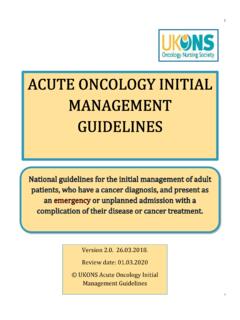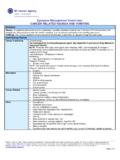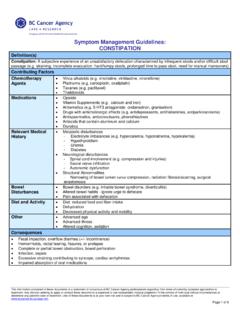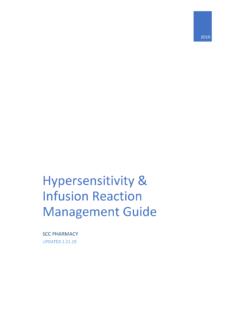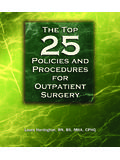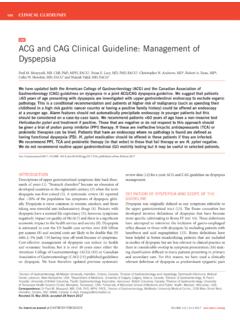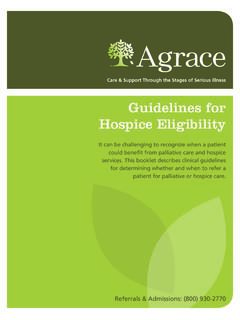Transcription of ACUTE ONCOLOGY INITIAL MANAGEMENT GUIDELINES
1 ! 1 ! 1 GUIDELINES for the INITIAL MANAGEMENT of adult patients who have a cancer diagnosis, and present as an emergency or unplanned admission with a complication of their disease or cancer treatment. UKONS ACUTE ONCOLOGY INITIAL MANAGEMENT GUIDELINES ACUTE ONCOLOGY INITIAL MANAGEMENT GUIDELINESV ersion DRAFT 2 (Review date: ).The following professional bodies have reviewed the GUIDELINES and support use in practice:! 2 IntroductionP. 4 General Information and Principles Guideline 1 Anaphylaxis/Allergic 2 Arthralgia/Myalgia P. 9 Guideline 3 Bleeding and/ or bruisingP. 1 0 Guideline 4 Chest PainP. 11 Guideline 5 ConstipationP. 1 2 Guideline 6 7 Dyspnoea/Shortness of BreathP. 1 5 Guideline 8 FatigueP.
2 1 6 Guideline 9 Metastatic Spinal Cord CompressionP. 1 7 Guideline 10 Mucositis/Stomatitis/OesophagitisP. 1 8 Guideline 11 NauseaP. 1 9 Guideline 12 Neutropenic 13 Skin 14 Skin Toxicities- Targeted Therapy RelatedP. 2 4 Guideline 15 Skin Rash Radiotherapy ReactionsP. 2 5 Guideline 16 Palmar Plantar Erythrodysesthesia (Hand Foot)P. 2 6 Guideline 17 VomitingP. 2 7 Guideline 18 Endocrinopathies - Adrenal Crisis P. 2 8 Guideline 19 Endocrinopathies - Hypophysitis P. 2 9 Guideline 20 Endocrinopathies -Thyroid DysfunctionP. 3 0 Guideline 21 Gastrointestinal Immune related Adverse EventP. 3 1 Guideline 22 Hepatotoxicities - Immune- related Adverse EventP. 3 2 Guideline 23 Neurological Immune- related Adverse EventP.
3 3 3 Guideline 24 Pneumonitis - Immune related Adverse EventP. 3 4 Guideline 25 Renal Toxicities P. 3 5 Guideline 26 Skin toxicities - Immune related Adverse EventP. 3 6 Guideline 27 Steroid TaperingP. 3 7 Guideline 28 Abdominal Ascites P. 3 8 Guideline 29 Carcinomatous Lymphangitis P. 3 9 Guideline 30 Central Venous Access Devices Problem ! 2! 3 Guideline 31 Cerebral/other CNS oedema /cerebral space occupying lesionP. 4 2 Guideline 32 Extravasation P. 4 3 Guideline 33 Hypercalcaemia of malignancy P. 4 4 Guideline 34 Hypomagnesaemia P. 4 5 Guideline 36 Malignant Pericardial Effusion P. 4 8 Guideline 37 Malignant Pleural Effusion P. 4 9 Guideline 38 Malignancy of Unknown Origin (MUO) Cancer of Unknown Primary (CUP)P.
4 5 0 Guideline 39 Pneumonitis Radiation and/or chemotherapy relatedP. 5 1 Guideline 40 Superior Vena Cava Obstruction (SVCO) P. 5 and development ! 3 DisclaimerThe information contained in these GUIDELINES is a consensus of the development and consultation groups views on current treatment. They should be used in conjunction with any local policies/procedures/ GUIDELINES and should be approved for use according to the trust clinical governance process. Care has been taken in the preparation of the information contained in the GUIDELINES . Nevertheless, any person seeking to consult the guideline, apply its recommendations or use its content is expected to use independent, personal medical and/or clinical judgment in the context of the individual clinical circumstances, or to seek out the supervision of a qualified clinician.
5 The United Kingdom ONCOLOGY Nursing Society makes no representation or guarantee of any kind whatsoever regarding the GUIDELINES content or its use or application and disclaim any responsibility for its use or application in any way.! 4 These GUIDELINES relate to the INITIAL assessment and immediate MANAGEMENT of ACUTE ONCOLOGY patients, patients presenting with an ACUTE problem, demonstrating symptoms deemed as having been caused by: Systemic Anti-Cancer Therapy (SACT) Radiotherapy Malignant disease A previously undiagnosed cancer where an urgent ONCOLOGY /haematology assessment is requiredIt is emphasised that these GUIDELINES focus on INITIAL assessment at presentation and MANAGEMENT for the first 24 hours.
6 Patients should be referred to, or discussed with the ACUTE ONCOLOGY Team as soon as possible following presentation. The ACUTE ONCOLOGY team will provide further advice and on-going MANAGEMENT aid in this urgent INITIAL assessment, each protocol follows a RAG (red, amber, green) format and quick reference assessment, which is in line with the UKONS ONCOLOGY /Haematology 24-Hour Triage Tool (V2, 2016): The Common Terminology Criteria for Adverse Events (CTCAE Version ), an international standard set of criteria for defining adverse events (AE) and their grading within clinical trials and the routine MANAGEMENT of ONCOLOGY /Haematology patients, has been applied to assist with the recognition and MANAGEMENT of AE.
7 Intended AudienceThese GUIDELINES are intended for use by all health care professionals who assess and/or manage ACUTE ONCOLOGY patients at presentation. The GUIDELINES may also be useful as an adjunct to the UKONS Triage tool when providing care advice following telephone triage (Appendix 1, ).They are mostly single-page see-and-treat guides. Whilst drug names may be referenced within a guideline, this is offered as a guide only: it is acknowledged that local variation may be aware of NICE National GUIDELINES /Pathways for the MANAGEMENT of:Neutropenic Sepsis: Metastatic Spinal Cord Compression: Metastatic malignant disease of unknown primary origin in adults: diagnosis and MANAGEMENT : development and consultation group worked to provide a set of generic GUIDELINES based on national guidance and clinical expertise.
8 They have now been reviewed and updated to ensure that they remain applicable and cover current best practice in the MANAGEMENT of treatment induced toxicity and ACUTE disease related complications. The authors request that the original source is acknowledged in all copies or adaptations.! 4 Introduction! 5 Please consider drug toxicity as a possible cause of presenting problem. Systemic Anti - Cancer Therapy (SACT) includes cytotoxic chemotherapy, monoclonal antibodies, targeted agents, immunotherapy and new and novel therapies. SACT toxicities can cause ACUTE deterioration but are often reversible if managed rapidly and appropriately. All patients on SACT may develop toxicities and are at risk; they may also have or develop additional toxicities to the one they are complaining of.
9 Patients may be on new, novel, or trial therapy, and may present with unexpected or unknown side effects. Patients should know what treatment they are receiving, and have written information about their SACT and an alert card with their 24-hour advice line telephone number. These advice lines provide telephone triage and assessment for patients receiving treatment and will advise regarding the need for urgent assessment or review and follow up. In most cases, if a patient or carer telephones your department for advice it would be wise to redirect their call to the specialist advice line. However, if you are worried about the patient or their ability to give an accurate history, or you think that this may be a medical emergency then urgent medical review is essential.
10 If a patient sounds unwell from SACT toxicities, it is sensible to arrange oncological/haematological review or assessment in hospital. If asking a GP or member of the primary health care team to review, it is essential to speak to them outlining what is required, what to look for and who to contact if further advice is needed. All licensed anticancer drugs have specific toxicities and the length of time that side effects can occur following completion of treatment varies. Most cytotoxic chemotherapies can cause side effects for up to 6 to 8 weeks after the last treatment is given. The newer immunotherapies and targeted agents can cause side effects for up to 2 years after the last treatment is administered please ask for details and/or advice from the ACUTE ONCOLOGY team, the site specific specialist team, the hospital pharmacy or see the Summary of Product Characteristics: Please see specific toxicity guideline and manage the patient according to their condition, severity, concomitant medications and other medical problems.
